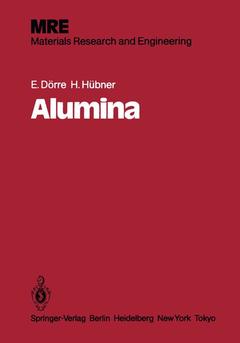Description
Alumina, Softcover reprint of the original 1st ed. 1984
Processing, Properties, and Applications
Coll. Materials Research and Engineering
Authors: Dörre E., Hübner H.
Language: French
Publication date: 12-2011
330 p. · 17x24.4 cm · Paperback
330 p. · 17x24.4 cm · Paperback
Description
/li>Contents
/li>
This is the third book in the new series "Material Research and Engineering", devoted to the science and technology of materials. "MRE" evolves from a previous series on "Reine und Angewandte Metallkunde", which was edited by Werner Koster until his eightieth birthday in 1976. For the new series, the presentation as well as the scope had to be modified. In particular, the scientific and technological links between volumes on metallic, non-metallic, and composite materials should reflect the successful development of materials science and engineering within the last two decades. Thus, the material provided by Dorre and Hlibner for the present volume is partic ularly welcome. Alumina as a ceramic material has received very large attention as an object of scientific investigation in all of its aspects. Additionally, it plays a leading role as a nonmetallic material in many fields of technical appli cation. This book deals with both aspects: in Chapter 2 (physical properties) and 3 (me chanical properties), H. Hlibner presents an outstanding documentation of what one might call the science of alumina, based on 560 literature references and 15 years of personal experience gained from experimental and theoretical work in university laboratories in Erlangen, Rio de Janeiro, and Hamburg. In Chapter 4 (fabrication) and 5 (applications), E.
1 Introduction.- 1.1 Scope of the Book.- 1.2 General Remarks on the Use and the Behavior of Ceramic Materials.- 1.3 The History of Alumina.- 1.4 Preceding Summarizing Literature on Alumina.- 2 Physical Properties.- 2.1 Structure.- 2.2 Thermal Properties.- 2.3 Diffusion.- 2.4 Electrical Conductivity.- 2.5 Sintering and Grain Growth.- 2.6 Hot Pressing.- 2.7 Segregation.- 3 Mechanical Properties.- 3.1 Elastic Properties.- 3.2 Fracture Strength.- 3.3 Time-Dependent Strength and Subcritical Crack Growth.- 3.4 Thermal and Mechanical Shock Resistance.- 3.5 Plastic Deformation.- 3.6 Creep.- 3.7 Strengthening Mechanisms.- 4 Fabrication.- 4.1 Preparation of Powders.- 4.2 Forming.- 4.3 Sintering.- 4.4 Hard Machining.- 4.5 Quality Control.- 4.6 Manufacturing Tolerances.- 4.7 Principles of Design.- 5 Applications.- 5.1 Electronic Applications.- 5.2 Mechanical Engineering Applications.- 5.3 Medical Applications.- 5.4 Armor Applications.- 5.5 Other Applications.- References.
© 2024 LAVOISIER S.A.S.




